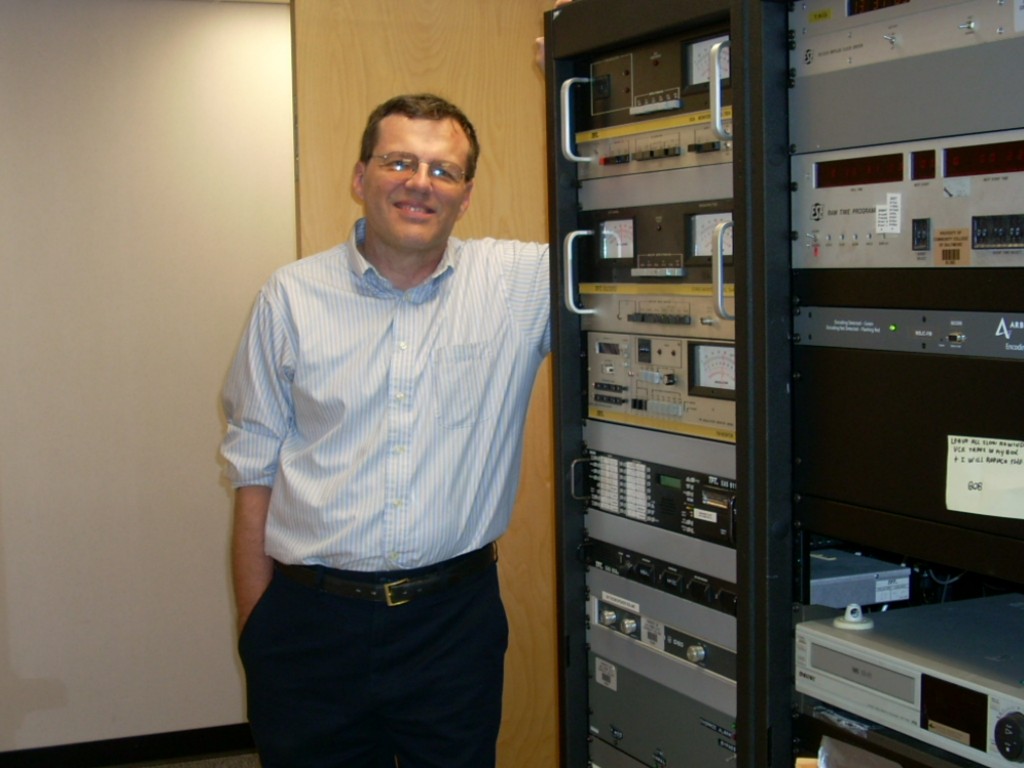Tuning Tips
How to get more when you just can’t get enough!
WBJC has a powerful 50,000 watts of clean FM signal, which reminds me that I came of age at a time when the radio tubes slowly warmed up and the AM stations were from Des Moines and New Orleans. FM is like television, mostly line of sight, but little fading and static. Now, everything goes on instantly (except for most of the radios in my collection) and no one cares about AM radio from Des Moines, New Orleans or where ever the talk is coming from outside the area.

Engineer Bob keeps this station going, sometimes with nothing more than a wad of gum, two paperclips and some slightly scorched hair
I’ve been chief engineer at 17 stations (sometimes several at one time) and now with WBJC, but all I’ve found through the years are some tricks to cure the still current problem of receiving a message through the ether. I’ll start first with some of the simpler reception problems that can be merely checking the socket where the radio or receiver is plugged in. Sometimes a bad connection, a socket which is turned off by a wall switch (to switch on lamps when entering a room) or some of the head slapping fixes are occasionally too easy to consider. If your radio has an AFC (automatic frequency control) on/off switch, try tuning the radio with the switch in the “off” position. Sometimes, when you use it to keep a station tuned in and the tuning changes, it can be very difficult to re-tune it. Leaving the switch in the “on” position could cause the tuning to pull to a stronger station on a nearby frequency. Those listening to a weaker station on a stereo receiver will experience a cleaner signal with the stereo/mono switched to mono. A monophonic signal has a greater usable range than a stereo signal.
Signal penetration into steel buildings can be a problem in many locations. Sometimes merely moving the radio a few feet away from the invisible steel beam in the wall can make a world of difference. Some radios have an antenna built into the line cord. If yours does (and you would have to check the instruction manual or original box to find out), try repositioning the line cord but be careful, chairs or a dish or two might go flying if you don’t watch the wire as you’re lifting it or stretching it to wrap around a vase. The same goes for radios with external wire antennas or whip antennas which extend from the tops of the radios, like one ear off the rabbit that used to sit on the TV. Trying to wield them can be like running with scissors or playing with BB guns.
When buying a radio it is best to go for one that has terminals for an external antenna. External antennas almost always provide superior performance. A place to start would be a flat wire external dipole antenna, again the same kind of wire leading from the old rabbit ears antenna to the back of the TV set. They are available at most electronic stores for under five dollars. However, avoid antennas with built in amplifiers. They often make the interference blocking WBJC’s signal even stronger and more difficult to handle. Often, one of these could be causing your reception problem from the start.
Personally, I have good luck with the GE SUPERADIO III. While mostly considered a powerful AM performer, I find it to be a decent FM radio at a reasonable price, usually $40 to $60. It is a big portable with good sound quality that can run on batteries or regular current and is attachable to an external antenna if need be.
If you are buying a radio specifically to cure WBJC reception problems, I would strongly suggest buying from a retailer that offers reasonable return privileges. There are just too many variables which affect your reception. Some high priced radios offer excellent sound quality through superior amplifiers and speakers, but only mediocre reception due to the design of their tuner (radio) section. They are only a good choice for listening to strong local stations. Also, radio receivers of all kinds have different ways to deal with blanket interference from nearby transmitters. If this type of interference is your problem, you may not be able to go by receiver specifications (what the company tells you the equipment will do) alone. The best thing is try it out various radios in your environment.
If you live outside the Baltimore metro area and considering an upgrade of your system in order to receive WBJC, you might want to check reception in the car while parked near the location that you plan put the radio. If there is not decent reception on the car radio, chances are that the equipment you have is not the problem and replacing it will not help; there might be distance or terrain conditions that cannot be overcome. If reception is decent in the car, but not in the home, an equipment upgrade would probably be in order. If relocating the radio and antenna do not help, it might be time to look into a roof antenna. (This can get kind of tricky). If your radio is connected to the TV/FM antenna that was feeding your TV in pre-cable days, remember that the antenna, hardware, and cabling probably have been exposed to the elements for many years. This could significantly reduce the efficiency of the antenna and even render it useless due to wear and corrosion. Even if all the gear is in good condition, there is a good chance that unless you have an antenna rotor (a wired-up remote control) with it, you are probably aimed at the TV stations (which, in Baltimore, are pretty much in a single location) rather than WBJC.
If you plan to purchase a new outdoor FM antenna, do not go for the omni (or all) directional varieties. An omni-directional antenna is easier to set up, but a directional yagi (think of the jungle of spidery roof antennas in the old days, but don’t ask about “conical” antennas) will offer better performance. You need not install a large TV/FM yagi antenna if you are only interested in FM reception. A yagi antenna designed for FM only is considerably smaller and less expensive; Radio Shack has a model in the twenty-dollar price range that will fit most needs. But unless you like to climb tall ladders, are unafraid of heights, built like a fireplug, or know first hand what you are doing, you might want to ask a handy man or woman to do the job for you. Then you and the person on the roof can yell at each other until the reception is maximized.
If none of these options can help you, give me a call at the station. I’ve spent 40 years trying to perfect my own system and I’ve got a few more hints up my sleeve.
excerpt from: My Life With A Screwdriver, Lenio, Bob
(Vol. xxxiv. Chapter 287b, page 1430, paragraph 2. First ed. rev.)





